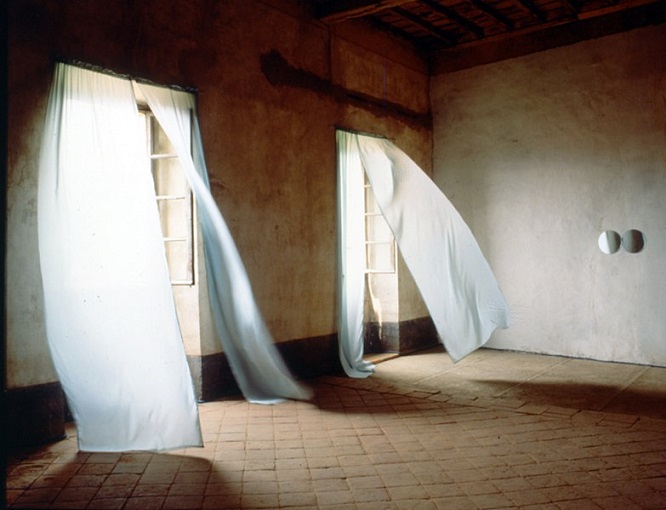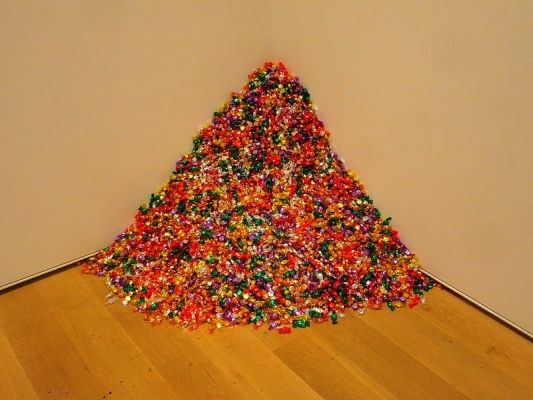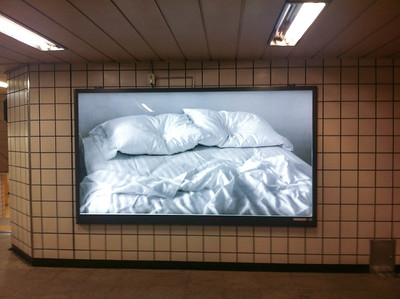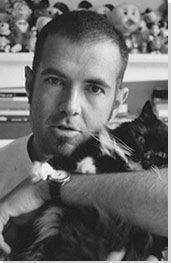Summary of Felix Gonzalez-Torres
As an openly gay man living through both the AIDS crisis and the extraordinary public politicization of art in the 1980s, Felix Gonzalez-Torres's groundbreaking installations are famous for their simplicity and affective impact, embedding poetic meditations on love and loss in the mundane material of everyday life. Although his career was brief, his legacy endures, particularly in political art and Relational Aesthetics, in which the audience is a necessary component, activating the work and realizing its meaning. Generous, austere, and often intended to be endlessly reproducible, his artwork continues to influence audiences in subtle but persistent ways.
Accomplishments
- Gonzalez-Torres's extraordinary contribution to contemporary art was to bring personal history and politics to the familiar forms of Minimalism and Conceptualism. Cube-like stacks of paper, strings of light, textual fragments, and the simple shapes of clocks, cellophane candies, and clouds were imbued with references to current events, including gay rights, gun violence, and the AIDS crisis.
- The portrait was an important genre for Gonzalez-Torres, one that allowed him to undermine the aesthetic autonomy of Minimalism. He used a system of parenthetic titles for otherwise "Untitled" works that point the viewer toward physical or personal associations the artist had with his various subjects. The idea of his installations as abstract portraits underscores the overall intimacy of his art by emphasizing his personal relationships with the people or places that inspired each particular work.
- Gonzalez-Torres wanted his work to be widely disseminated and he believed it was not fully realized without the participation of the viewer. "Without the public these works are nothing...I ask the public to help me, to take responsibility, to become part of my work, to join in." Although some of these ideas had emerged in the manifestos of movements like Dada, Surrealism, and the Happenings of the 1960s, Gonzalez-Torres's total openness to the viewer inaugurated a new era in the relationship between the artist and the audience.
- He transformed everyday objects such as candies and photocopies, often in installations that allow visitors to take these objects with them when they leave. These works radically model the democratic circulation of ideas and art, violating boundaries between public and private spaces, and extending the experience of his art beyond the gallery.
Important Art by Felix Gonzalez-Torres

"Untitled" (Loverboy)
"Untitled" (Loverboy) consists of two sets of gauzy light blue curtains hanging in front of open (or closed) windows. The work showcases Gonzalez-Torres's ability to move the viewer with simple but evocative materials that reference the rich history of modern art, while leaving the final meaning of the work open to interpretation. French windows and curtains may be commonplace fixtures, but they assume new meaning when encountered in a fine art installation. Here, the windowpane's grids immediately recalls similar forms in early-20th-century paintings like those by Piet Mondrian and masterworks of Minimalism by artists including Donald Judd and Sol Lewitt.
And yet the delicate and diaphanous curtains are closer in tone to the Post-minimalist works of Eva Hesse, whose Continent series had a strong impact on the young Gonzalez-Torres. As they quiver in the wind, the sheer curtains serve as reminders of human habitation in a space that is otherwise left empty. The fabric records the slightest outside breeze or movement within the gallery, becoming a fragile visual representation of unseen, absent forces. The open windows further suggest a sudden or unplanned exit, foreshadowing the loss of the artist's longtime partner, Ross Laycock, who was living with AIDS.
Objects in Gonzalez-Torres's oeuvre often come in twos: curtains, clocks, pillows, and other pairs are allegories for romantic unions (particularly his relationship with Laycock). Following Laycock's death in 1991, Gonzalez-Torres produced a public billboard, "Untitled", an image of two pillows, each with a central depression, signifying the absence of the corresponding bodies. Like the present work, the billboard images evoked themes of intimacy, loss, and mortality.
Blue fabric and hanging device

"Untitled" (Perfect Lovers)
"Untitled" (Perfect Lovers) is an installation of two identical, battery-operated clocks, synchronized and hanging side-by-side. As ordinary objects elevated to the level of fine art, the clocks undoubtedly reference the Duchampian readymade, and, with their austere forms and serial repetition, Minimalist sculpture. Like all of Gonzalez-Torres's works, however, mundane materials are springboards for subtle personal and political meanings that vary with their context. The viewer's response to the clocks shifts dramatically knowing that the artist created the installation while his partner Ross Laycock was dying from AIDS. Gonzalez-Torres acknowledged that clocks would fall out of synch, one eventually stopping first. "Time is something that scares me . . . or used to. This piece I made with the two clocks was the scariest thing I have ever done. I wanted to face it. I wanted those two clocks right in front of me, ticking."
On the other hand, the clocks exemplify his desire to create works with multiple possible meanings. Although it obviously reflects his own homosexual relationship, the abstract nature of the clocks' substitution for bodies allows it to be read generally, as a metaphor for love. Gonzalez-Torres explained how he resisted the label of "gay art" during a period of increased censorship and furor over the NEA funding for Robert Mapplethorpe: "Two clocks side by side are much more threatening to the powers that be than an image of two guys sucking each other's dicks, because they cannot use me as a rallying point in their battle to erase meaning. It is going to be very difficult for members of Congress to tell their constituents that money is being expended for the promotion of homosexual art when all they have to show are two plugs side by side, or two mirrors side by side..."
Gonzalez-Torres often produced multiple versions of his installations, and his detailed instructions for their display became an important element of the piece itself. For "Untitled" (Perfect Lovers), the instructions require the commercial clocks to be of exact dimensions and design and that they touch; before the exhibition opens the hands are set to the same time; an essential part of the work is that the clocks can be perpetually reset and, therefore, the work is infinite. A rule around the work is that the clocks can fall out of sync but if one of the clocks stop, they are fixed or replaced, as the case may be. With such directions, Gonzalez-Torres created the basic boundaries of the work, while still allowing for certain flexibility in any given exhibition or installation.
Dallas Museum of Art
"Untitled" (Death by Gun)
The stack of posters, "Untitled" (Death by Gun), reproduces a composite image of 460 individuals killed by gunshots in a single week in the United States. Each copy includes the name, age, and circumstances surrounding the individual's death. Gonzalez-Torres encouraged museumgoers to take one of the photolithographs from the stack, allowing for exhibitors to renew the stack as it was depleted. Again, the artist played with the conventions of the boxy, Minimalist sculptures of Donald Judd and Carl Andre - reworking their solid forms as a constantly changing cube.
Although it may seem that by calling attention to gun violence Gonzalez-Torres was suggesting the Minimalists had avoided politics, in fact he was consciously updating their phenomenological strategy, which insisted on the viewer as the point of interpretation and activation of the work.
Gonzalez-Torres, along with other artists associated with relational aesthetics and the Pictures Generation, furthered the concept of participation as a political act. Instead of simply walking across a sculpture, as with Andre's floor sculptures, the audience takes a piece of it home with them. "Untitled" (Death by Gun) also relates to the political legacy of printmaking as a cheap and easy way to distribute information, raise awareness, and galvanize the public.
Print on paper, endless copies - The Museum of Modern Art, New York
"Untitled" (Go-Go Dancing Platform)
"Untitled" (Go-Go Dancing Platform) is just that: an austere box, painted white, with bare incandescent bulbs tracing the perimeter. For the vast majority of the time, it is an unused stage, activated only by the presence of an actual Go-Go dancer. Gonzalez-Torres did not specify the gender of the Go-Go Dancer, but he did insist that he or she wear silver lame bottoms.
The artwork offers a host of art historical and social meanings. Like many of the artist's hard-edged, modular works, it recalls Minimalist sculpture, but the addition of a living human invests the formal movement with what SFMOMA curator Gary Garrels has described as a "kind of poetic, romantic, social, and cultural dimension." Furthermore, a barely clad Go-Go dancer in the middle of a museum can only be described as somewhat out of the ordinary - a dreamlike or absurd situation that represents a postmodern continuation of Surrealist strategies, as well as a kind of "happening" in the spirit of the impromptu events first realized by avant-garde artists such as Alan Kaprow in the 1960s.
Lastly, the "Untitled" (Go-Go Dancing Platform) introduces a blatantly homoerotic moment to the space of the museum, where scenes of heterosexual desire are typically dominant. For centuries gay artists and gay subjects were suppressed, marginalized, or white-washed, and Gonzalez-Torres was determined to reverse this process.
Wood, light bulbs, acrylic paints and Go-Go Dancer in silver lame bikini (when installed publicly) - Private Collection
"Untitled" (It's Just a Matter of Time)
"Untitled" (It's Just a Matter of Time) was originally exhibited in conjunction with the exhibition "Gegendarstellung: Ethics/Aesthetics in Times of AIDS" at the Kunstverein in Hamburg, Germany. The phrase "It's Just a Matter of Time" was set in a classic blackletter, or Fraktur typeface, prompting immediate associations with Nazi Germany, during which it was used heavily as the "true" German script. During the Hamburg exhibition, billboards with the same phrase were erected in many cities across the world; the sign was translated to the official language of each country, including examples in Japan, India, Colombia, Canada, and a number of European cities.
Gonzalez-Torres appropriated the billboard format, which is inextricably linked with commerce, to promote a less tangible product: awareness. The billboard exhorts the public to consider how often similar spaces advertise worthless, interchangeable products in the face of urgent social issues, such as the fight against AIDS. And yet, like most of his work, despite how direct the billboard message is, Gonzalez-Torres leaves room for contradictory conclusions and interpretations, imploring the viewer to supply its meaning.
The phrase "It's Just a Matter of Time" is a dependent clause without an accompanying one to complete it, emphasizing both vagueness, and serving as a metaphor for isolation, and the many who lost loved ones to the disease, including the artist himself. It is only a matter of time, until what? The public is forced to answer the question for themselves, placing themselves within (rather than outside) the evolving conversation about AIDS, sexuality, and public health that was taking place in the early 1990s.
Public billboard

"Untitled" (Portrait of Ross in L.A.)
This is one of Gonzalez-Torres's most recognizable works, consisting of an endlessly renewable pile of individually wrapped candies with an "ideal" total weight of 175 lbs., a number that corresponds to his partner Ross's healthy weight (before he contracted HIV). Known colloquially as a "candy spill," the artist produced a number of similar works, in different sizes, colors, and shapes. They diminish as visitors take candy from the pile, and are then replenished, in a cycle reminiscent of life and death. Many of the spills were considered portraits, their forms suggested by some aspect of a person; weight, color, or to other personal associations the artist made.
Gonzalez Torres once remarked that "the most successful of all political moves are ones that don't appear to be 'political.'" Although many visitors to a "candy spill" experience it as an illicit, pleasurable moment in the highly regulated environment of a museum gallery, the artist may have also intended a darker meaning. As the viewer unwraps and eats the candy, he or she becomes complicit in the disappearing process - akin to the years-long public health crisis of HIV/AIDS, during which many stigmatized the disease as "gay cancer," leading to the failure to adequately support research or treatments, and ultimately, to thousands of early deaths.
Candies, individually wrapped in multicolored cellophane
"Untitled" (Petit Palais)
The two intertwining strands of blubs that comprise "Untitled" (Petit Palais) cascade from the ceiling, forming a pool of light on the ground. The artist created twenty-four different "light-strings" and though they are similar, they have different titles, number of bulbs, and number of strings.
When asked how the piece should be displayed, Gonzalez-Torres responded: "I don't necessarily know how these pieces are best displayed. I don't have all of the answers - you [the owner] decide how you want it done. Whatever you want to do, try it. This is not some Minimalist artwork that has to be exactly two inches to the left and six inches down. Play with it, please. Have fun. Give yourself that freedom. Put my creativity into question..." This desire for an infinite number of open-ended possibilities relates to the artist's belief in leaving the final meaning of his work to the audience (and the local institution that presents it). His insistence on mutability may have helped extend the relevance of his work for new generations, as they are reinterpreted in new contexts.
Like so much of his work, the light-strings transform the familiar into the disquieting, in a beautiful meditation on love (the embrace of the strings), and life and death (light and dark). These associations are further emphasized by the lights' ephemeral nature, which burn out and must be replaced.
Light bulbs, porcelain light sockets and extension cords - The Philadelphia Museum of Art
Biography of Felix Gonzalez-Torres
Childhood and Education
Felix Gonzalez-Torres was born in Guaimaro, Cuba in 1957, the third of four children. He and his sister Gloria relocated that year to an orphanage in Madrid, Spain before eventually settling in Puerto Rico with their uncle. He graduated from Colegio San Jorge in 1976, and began to take art classes at the University of Puerto Rico while becoming involved in the local art scene.
In 1979, he moved to New York City to pursue a degree in photography at Pratt Institute. This was an exciting time to be in New York: artists were responding to the exhaustion of the Minimalist movement with the opposing strategies of Neo-Expressionist painting and the various approaches of Postmodernism, often emphasizing photography, appropriation, and cultural critique. During this period Gonzalez-Torres participated in the Whitney Independent Study Program twice, once in 1980 and a second time in 1983, the year he received his BFA. In 1987 he received an MFA from the International Center of Photography, but it was the Whitney program that he credited with introducing him to the theoretical framework that shaped his early artistic practice.
In a 1993 interview with artist Tim Collins, Gonzalez-Torres said that feminism and the writings of philosophers Roland Barthes, Bertolt Brecht, Walter Benjamin, and Michel Foucault (among others) were critical to his development. "[Without them] I wouldn't have been able to make certain pieces, to arrive at certain positions. Some of their writings and ideas gave me a certain freedom to see. These ideas moved me to a place of pleasure through knowledge and some understanding of the way reality is constructed, of the way the self is formed in culture, of the way language sets traps, and of the cracks in the 'master narrative,' those cracks where power can be exercised."
One of Gonzalez-Torres's most significant inspirations was his long-term relationship with Ross Laycock. Laycock was a Canadian who moved to New York in 1980, though he later returned to Toronto to study biochemistry and English, before eventually becoming a sommelier and AIDS activist. The two met in 1983 and were "intertwined like a helix." Following a lengthy illness, Laycock died of AIDS-related complications in 1991; his life and his loss had a profound effect on Gonzalez-Torres, who wrote that his art was "First and foremost [...] about Ross."
From 1987 to 1991 Gonzalez-Torres was an active member of Group Material, a New York based collective founded in 1980 by artists including Julie Ault, Tim Rollins, and Doug Ashford. By the time he became a member, the group was small but well known for their collaborative ethos (against the authorial voice of a single artist), cultural activism, and Institutional Critique. Group Material used the exhibition as their medium, calling attention to social issues like homelessness, US intervention in Latin America, gender inequality, and sexuality. Most of all, Group Material shared his belief that aesthetics and politics are inseparable - refusing to be labeled "political" artists, their work, and Gonzalez-Torres's individual practice, insisted on the importance of the aesthetic experience and personal history. Incorporating these influences, Gonzalez-Torres took up the legacies of Minimalism and feminism in surprisingly simple but affective ways.
Mature Work

Many of Gonzalez-Torres's mature artworks were series or editions that iterated on similar materials or forms. The most famous of these include his "datelines" of text and dates printed on monochromatic backgrounds, begun in 1987, and which later evolved into his word-portraits; the billboards and stacks, which both originated in 1989 as public art anti-monuments; the light-strings, which first appeared in 1991 when his lover Laycock died; and the candy spills, which emerged in 1990.
Gonzalez-Torres's rise to prominence in the late 1980s was swift. Following his third solo gallery show in New York in 1988, the artist was invited to do a solo project at the New Museum. In 1989, the Berkeley Art Museum and the Pacific Film Archive asked Group Material to participate in an exhibition at the MATRIX Gallery in Berkeley, California focused on the AIDS epidemic. Also, in 1989, Gonzalez-Torres erected a billboard in Sheridan Square, New York City, commemorating the 20th anniversary of the Stonewall Rebellion, the uprising by members of the LGBTQ community against police oppression considered a seminal event in the gay rights movement. During this year, he also began producing the "stacks" of pages printed with text and/or images that the artists intended to be depleted and replaced as gallery goers took sheets from the pile.
In 1990, Gonzalez-Torres began exhibiting with Andrea Rosen Gallery, which continues to represent the estate of the artist today. The same year, during Roni Horn's solo exhibition at the Museum of Contemporary Art in Los Angeles, Gonzalez-Torres encountered her Gold Field (1980-82) sculptures, consisting of two pounds of gold compressed into a radiant rectangular mat. Later, he created his candy spills, comprised of either piles or carpets of wrapped candies, many of which were explicitly portraits or metaphors for the body. Acknowledging Horn's influence, Gonzalez-Torres created a gold cellophane candy spill inspired by her, named "Untitled" (Placebo - Landscape - for Roni). That year, he was honored with a fellowship from the National Endowment for the Arts for the second time (the first was in 1989).
In 1991, Gonzalez-Torres's partner of eight-years, Ross Laycock, passed away from complications related to the AIDS virus. Coinciding with this tragic loss was a time of fertile productive output, during which the artist inaugurated some of his most impactful works. In 1991, the artist also realized the first examples of his curtains of gilded beads, which suggest the possibility of a mystical portal into another dimension (or afterlife), and evoke the orbs that present in a molecular model - an oblique reference to the scientific efforts to find a cure for HIV/AIDS. Gonzalez-Torres also first debuted his light string sculptures consisting of two intertwining cords connected to an array of low-wattage lightbulbs - a poetic and stirring meditation on mortality and loss. In 1992, he was granted a DAAD fellowship to live and work in Berlin. Toward the end of his life he had several important museum exhibitions, including a retrospective at the Guggenheim (1995) and "Traveling," which went from the Museum of Contemporary Art, Los Angeles to the Hirschhorn Museum, Washington, D.C. and the Renaissance Society, Chicago (1994).
The artist continued to innovate despite his own illness, repurposing materials that might otherwise be excluded from a fine art gallery, but that he found beautiful or meaningful. He created a series of curtains of plastic beads, for example, whose titles, like "Untitled" (Chemo) and "Untitled" (Blood), caused typically dissonant associations in contrast to their visual appearance, which evoke festive decorations and discos. Gonzalez-Torres died in Miami of AIDS-related illness complications in 1996. He was 38 years old.
The Legacy of Felix Gonzalez-Torres
The Felix Gonzalez-Torres Foundation was set up in 2002 to honor and continue the artist's legacy. In 2007, Gonzalez-Torres became the second American artist, after Robert Smithson, to be posthumously chosen to represent the United States at the Venice Biennale. Gonzalez-Torres's body of work continues to resonate with a new generation of artists, searching to create stirring and interactive art experiences, and to produce subtle artworks that are both politically radical and stand on their own as aesthetic objects. The combination of minimalist forms and personal history evident in the work of Alex Da Corte also reflects the conceptual influence of Gonzalez-Torres, as does the audience participation aspect of Tino Sehgal and Rikrit Tiravanijas' practices. His influence is also clearly felt in the work of artists who use performance or forms of abstraction to address urgent social and political issues, including Doris Salcedo and Santiago Sierra.
Influences and Connections

-
![Roni Horn]() Roni Horn
Roni Horn ![Julie Ault]() Julie Ault
Julie Ault- Doug Ashford
- Tim Rollins
- Jim Hodges
![Julie Ault]() Julie Ault
Julie Ault
- Doug Ashford
- Tim Rollins
- Jim Hodges
- General Idea





























